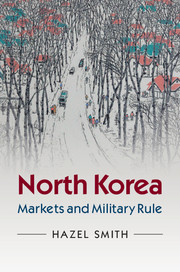Book contents
- Frontmatter
- Dedication
- Contents
- Acknowledgements
- Introduction: North Korea: politics, economy and society
- Part I Jettisoning caricatures: understanding history
- Part II The rise and fall of Kim Il Sungism
- Part III Marketisation and military rule
- 9 Marketisation from below
- 10 Military rule from above
- 11 The marketisation of well-being
- 12 The marketisation of the social structure
- 13 Going nuclear
- 14 Strategic paralysis
- 15 North Koreans as agents of change
- Bibliography
- Index
12 - The marketisation of the social structure
from Part III - Marketisation and military rule
Published online by Cambridge University Press: 05 May 2015
- Frontmatter
- Dedication
- Contents
- Acknowledgements
- Introduction: North Korea: politics, economy and society
- Part I Jettisoning caricatures: understanding history
- Part II The rise and fall of Kim Il Sungism
- Part III Marketisation and military rule
- 9 Marketisation from below
- 10 Military rule from above
- 11 The marketisation of well-being
- 12 The marketisation of the social structure
- 13 Going nuclear
- 14 Strategic paralysis
- 15 North Koreans as agents of change
- Bibliography
- Index
Summary
The Kim dynasty remained at the apex of the restructured social hierarchy but the social structure over which the Kim family presided became more fragmented and less stable. The formal occupational structure remained similar to that which existed in the Kim Il Sungist era but there was no longer a reliable correlation between occupational and social status. Party members found that political status still counted for something in North Korea but, in the context of market realities, perennial food shortages, low incomes and high prices, economic entrepreneurial skills mattered more.
Women as a social group remained in low-status, physically arduous and dirty jobs; over half a million women worked as labourers in 2008. A minority secured good jobs and high-status positions but low pay pushed many women into the marketplace to supplement their income. Formerly high-status groups found that they were no longer privileged economically and socially. Professionals, the industrial working class, farmers on agriculturally productive farms and the ranks of the armed forces saw their fortunes plummet. A new class of nouveau riche emerged whose ostentatious lifestyle was based around the capacity to privately accumulate wealth.
The government viewed young people as the social group most likely to become politically disaffected and refocused mass mobilisation policies to an almost exclusive concentration on young people. Military-led command-and-obey organisation supplanted previous Party-led techniques that had offered rewards as well as penalties for participation in mass mobilisation into the military, civil defence and economic construction. Forced mobilisation served to keep young people occupied and managed but could not hide the obvious failings of the government. Inefficacy of the propaganda machine and greater understanding of the outside world only confirmed the bankruptcy of government policies.
The fragmentation of the old elites
During the military-first era, a narrowly based, non-accountable and interdependent civilian and military elite continued to preside over the state and society. Power and politics continued to coalesce around a network of oligarchies, the most important of which was the Kim Il Sung dynasty.
- Type
- Chapter
- Information
- North KoreaMarkets and Military Rule, pp. 279 - 293Publisher: Cambridge University PressPrint publication year: 2015



